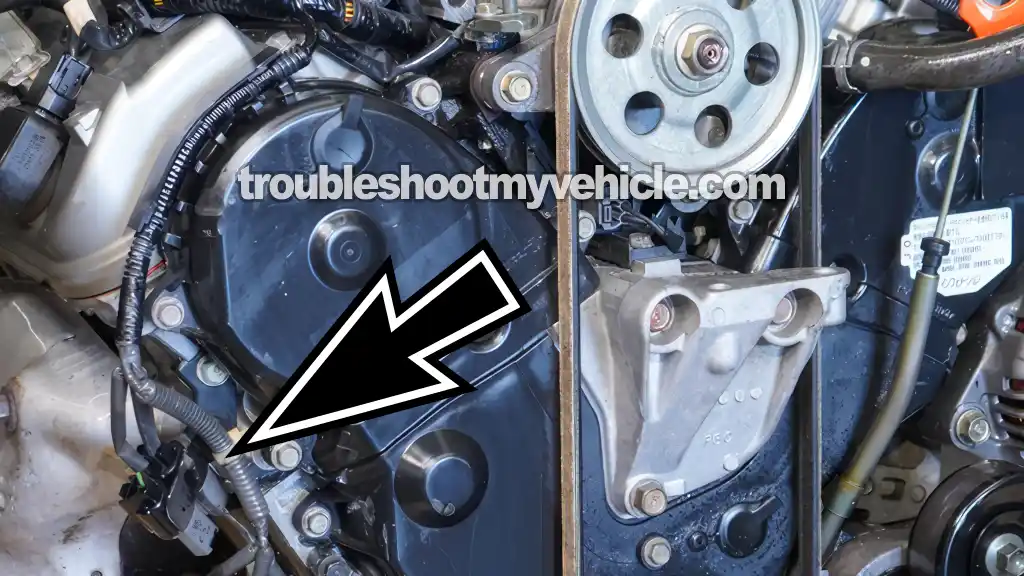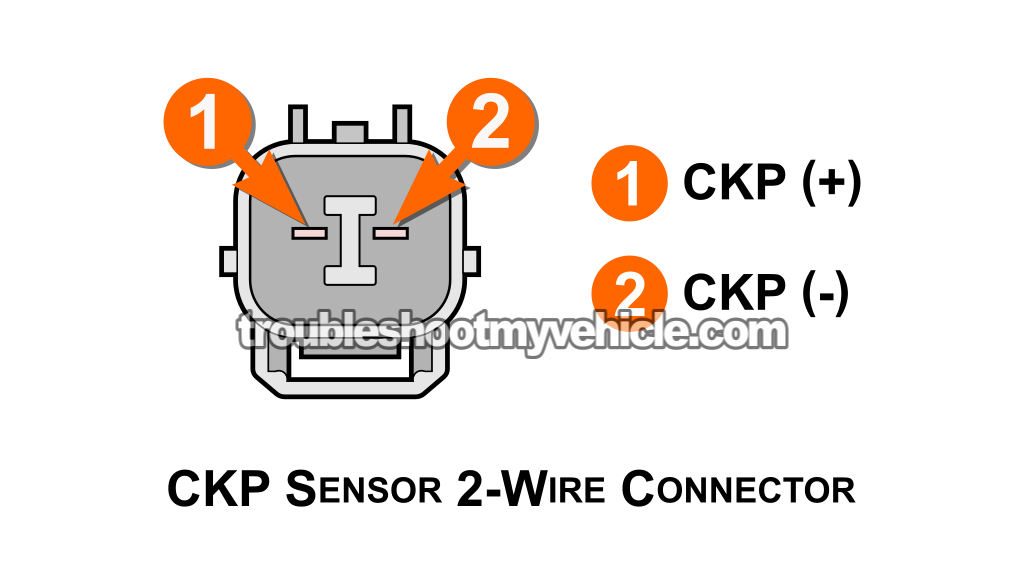
When the crankshaft position (CKP) sensor fails, you'll usually see trouble codes P0335: CKP Sensor No Signal or P0336: CKP Sensor Intermittent Interruption.
In this tutorial, I'll walk you through two simple tests to check whether the sensor is working —and see if the sensor is toast.
So, if your Honda cranks but won't start —or runs rough and sets a CKP sensor code— you've come to the right place.
Let's get started and find out what's really going on.
Contents of this tutorial:
APPLIES TO: This tutorial applies to the following vehicles:
- 3.0L V6 Honda Accord: 1998, 1999, 2000, 2001, 2002.
- 3.0L V6 Acura CL: 1997, 1998, 1999.
IGNITION SYSTEM WIRING DIAGRAM: The following wiring diagram complements the info in this tutorial.
IGNITION SYSTEM TESTS:
- How To Test The Ignition Coil And Basic System Checks (1998-1999 3.0L V6 Honda Accord).
- How To Test The Ignition Control Module (1998-1999 3.0L V6 Honda Accord).
- How To Test The Coil-On-Plug Ignition Coil (2000-2003 3.0L V6 Honda Accord).
- How To Test The CMP Sensors (1998-2002 3.0L V6 Honda Accord).
Symptoms Of A Bad CKP Sensor
The crankshaft position (CKP) sensor is one of the most critical sensors in your Honda's ignition and fuel systems. It works hand-in-hand with the camshaft position (CMP) dual sensor assembly to get the engine started and keep it running smoothly.
When the CKP sensor fails, the PCM can't detect crankshaft speed —which will affect the delivery of spark or fuel, and the engine won't start.
If CKP sensor is failing intermittently (cutting in and out at randomly), the engine might start sometimes, stall randomly, or misfire under load.
Generally, when a CKP sensor or circuit failure occurs, you'll see one of these two codes:
- P0335: CKP Sensor No Signal —This code is the result of a completely dead sensor or an electrical problem in the CKP sensor circuits keeping the CKP signal from reaching the PCM.
- P0336: CKP Sensor Intermittent Interruption —This code gets set when the signal is weak or intermittent.
Both of these codes point to a sensor that's either not sending a signal at all —or sending one the PCM can't rely on.
Here's a breakdown of the most common symptoms you'll see when the CKP sensor goes bad:
- Engine cranks but does not start.
- No spark at the ignition coil or spark plugs.
- No fuel injector pulse.
- Engine stalls randomly while driving (typically with P0336).
- Extended cranking time before the engine starts.
If you're dealing with any of these symptoms —or you've scanned the PCM and found a P0335 or P0336— the next step is to check the CKP sensor itself. And in this tutorial, I'll show you how.
If your Honda is suffering from an engine no-start problem, I've got a full tutorial that dives deeper into the most common causes, how to test them and resolve them:
CKP Sensor Connector Location

The crankshaft position (CKP) sensor itself, on the 1998–2002 3.0L V6 Honda Accord, is located behind the lower timing belt cover and next to the crankshaft timing gear.
But the sensor's 2-wire connector is easier to access —it's located outside the timing belt covers. Specifically, it's mounted to a small bracket next to the upper timing belt cover of the cylinder head closest to the firewall.
The CKP sensor connector shares that bracket with one or two other connectors, so you'll need to double-check wire colors to make sure you're working with the right one. The CKP sensor's 2-wire connector will have a blue (BLU) wire and a white (WHT) wire.
One important thing I want to point out —because of the tight space around the connector, you'll need a pair of jumper wires with insulated alligator clips to easily connect your multimeter probes to the CKP sensor terminals.
If you don't already have a set, these are the ones I personally use and keep in my tool box:
- Jumper Wires With Insulated Alligator Clips (Amazon affiliate link).
Next, we'll test the CKP sensor's internal resistance to see if it's still in spec.
TEST 1: Checking The Resistance Of CKP Sensor

We're gonna start off by checking whether the crankshaft position (CKP) sensor has failed internally using a simple multimeter resistance test.
Most of the time, the CKP sensor fails in one of two ways:
- Internal open-circuit problem: If the sensor has an internal open, your multimeter will show an infinite resistance reading (OL).
- Internal short-circuit problem: If the sensor is shorted internally, the reading will show zero Ohms.
What you want to see is a resistance value between 1850 and 2450 Ohms —which is the factory spec at ambient temperature.
Before running this test, make sure the engine is completely cool. The resistance spec is only valid when the engine is at ambient temperature.
If you don't already have a multimeter, here's the one I personally use and recommend:
- Tekpower TP8268 AC/DC Auto/Manual Range Digital Multimeter (Amazon affiliate link).
IMPORTANT: This test —and the next one in TEST 2— must be performed on the connector with the male spade terminals. That's the actual connector coming from the CKP sensor itself. The matching connector with the female terminals is part of the engine wiring harness, and its wires run to the PCM.
These are the test steps:
- 1
Disconnect the CKP sensor connector.
- 2
Set your multimeter to its Ohms (Ω) setting.
- 3
Connect one multimeter lead to each of the male terminals on the CKP sensor.
The easiest way to do this is by using jumper wires with insulated alligator clips to connect the multimeter test leads to the male terminals on the connector. - 4
Your multimeter should register a value between 1850 and 2450 Ohms.
Let's interpret that multimeter reading:
CASE 1: The sensor's resistance is within spec. That's what we want —it means the CKP sensor isn't damaged internally.
But we're not done yet. The next step is to check the sensor in action while cranking the engine, to confirm it's generating an usable signal. Go to: TEST 2: Checking The CKP Sensor Signal With The Engine Cranking.
CASE 2: The sensor's resistance is out of spec. If you got zero Ohms, infinite resistance, or any other value not within the spec, the sensor is toast.
Replace the CKP sensor to resolve the P0335 or P0336 issue and get your Honda back on the road.
TEST 2: Checking The CKP Sensor Signal With The Engine Cranking

Now that you've confirmed the CKP sensor's internal resistance is within spec, the next step is to make sure it's actually producing a signal while the engine is cranking. This is a live test that checks whether the sensor is generating an AC voltage pulse when the crankshaft is turning.
If there's no signal, the PCM won't know the engine is cranking —which will trigger a P0335: CKP Sensor No Signal trouble code.
If the signal cuts in and out while cranking or driving, you might see P0336: CKP Sensor Intermittent Interruption. Either way, this test helps you confirm whether the sensor is working in real-world conditions.
The multimeter should report a fluctuating AC voltage —typically between 0.5 and 1.0 Volts AC— while cranking the engine.
NOTE: This test must be done at the CKP sensor connector with the male spade terminals (the sensor side). Use insulated alligator clip jumper wires to connect your multimeter leads, since the connector is in a tight spot.
IMPORTANT: Make sure your battery is fully charged before testing the CKP sensor signal. If your battery is weak or low, take a moment to recharge it so you can get an accurate result. A fully charged battery will ensure the fastest engine cranking speed and a more accurate reading of the CKP signal.
CAUTION: Be careful when working near the engine while it's cranking. Keep hands, tools, and clothing away from moving parts like the serpentine belt and power steering pump pulley to avoid injury.
Alright, let's get the ball rolling:
- 1
Fully charge the battery if it's low or weak.
A weak battery will cause the engine to crank slowly, which can prevent the CKP sensors from generating a strong AC signal. - 2
Set your multimeter to Volts AC.
- 3
Connect your multimeter leads to the two jumper wires that are connected to the CKP sensor's BLU and WHT wires.
- 4
Have a helper crank the engine while you watch the multimeter.
- 5
You should see an AC voltage reading between 0.7 and 1.2 Volts AC.
Let's break down what your results mean:
CASE 1: You got a fluctuating AC voltage while cranking. That's what we want —the CKP sensor is generating a signal and points to a good sensor.
If you're still getting a CKP sensor trouble code (P0335 or P0336), there's a good chance that:
- The CKP sensor is failing intermittently.
- The CKP sensor signal isn't reaching the PCM due to a problem in the wiring between its connector and the PCM.
Your next step is to check for continuity between the CKP sensor connector and the PCM.
CASE 2: You got NO AC voltage while cranking. That means the CKP sensor isn't producing a signal —and the PCM has no idea the engine is turning.
This will definitely cause a P0335, and may also trigger P0336 if the signal is intermittent or weak. The sensor is bad and needs to be replaced.
More 3.0L V6 Honda Accord Diagnostic Tutorials
I've written quite a few how-to guides for the 3.0L V6 Honda Accord, written with both DIYers and experienced techs in mind. You can find them all in this index:
Here's a quick peek at some of the step-by-step tutorials you'll find there:
- How To Troubleshoot A No Start (1998-2007 3.0L V6 Honda Accord).
- How To Test For A Broken Timing Belt (1998-2007 3.0L V6 Honda Accord).
- How To Test a Misfire Condition and Misfire Codes (3.0L V6 Honda Accord).
- How To Test Engine Compression (1998-2007 3.0L V6 Honda Accord).

If this info saved the day, buy me a beer!

